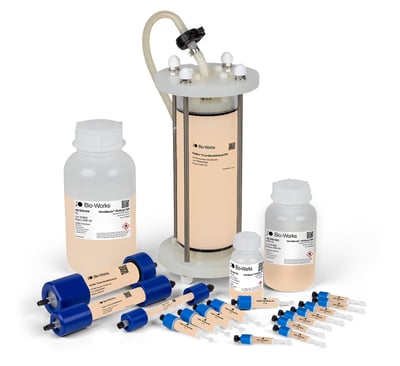Hydrophobic interaction chromatography (HIC) resins
WorkBeads resins for hydrophobic interaction chromatography (HIC) are designed for intermediate purification of biomolecules by utilizing the difference in their surface hydrophobicity.
Products
Hydrophobic interaction chromatography (HIC) resins
HIC resins that offer reliable binding performance
 WorkBeads™ 40 Butyl SH is a resin for hydrophobic interaction chromatography (HIC) designed for research and industrial scale purification of proteins, peptides, plasmids, and oligonucleotides by utilizing the difference in their surface hydrophobicity. It’s often used to complement other techniques that separate according to either charge or size.
WorkBeads™ 40 Butyl SH is a resin for hydrophobic interaction chromatography (HIC) designed for research and industrial scale purification of proteins, peptides, plasmids, and oligonucleotides by utilizing the difference in their surface hydrophobicity. It’s often used to complement other techniques that separate according to either charge or size.
- High throughput, binding capacity, and purity
- High chemical stability for easy cleaning-in-place and reproducible results
- Prepacked GoBio columns for convenience and reproducibility
The functional ligand of WorkBeads 40 Butyl SH is n-butyl thioether. Since butyl is a very hydrophobic linear chain, minimal mixed-mode interactions are expected. The resin is optimized to offer reliable binding performance. The property of high-resolution separation, in combination with low backpressure, allows both capture and polishing purification applications in standard bioprocess columns. The resin is also available in several different ready-to-use prepacked column sizes, such as GoBio™ Mini 1 mL and 5 mL, GoBio Screen 7 x 100 (3.8 mL), GoBio Prep 16 x 100 (20 mL) and 26 x 100 (53 mL) as well as GoBio Prod columns starting at 1 L.
Principle of hydrophobic interaction chromatography (HIC)
Hydrophobic interaction chromatography (HIC) separates molecules according to differences in their surface hydrophobicity through a reversible interaction between the molecules and the hydrophobic surface of the HIC resin. A high salt concentration enhances the interaction, and a low salt concentration weakens the interaction. The extent of the reversible interaction between the molecule and the hydrophobic surface of a HIC resin depends on the properties of the HIC resin and target molecule, and the running conditions, such as the salt concentration. The principle for molecule adsorption to HIC resins is orthogonal to ion exchange and size exclusion chromatography.
In HIC, the molecules to be separated are usually loaded onto the column under conditions of a high salt concentration, which promotes the exposure of hydrophobic regions and increased hydrophobic interactions. As the sample is applied, molecules with higher hydrophobicity tend to bind more strongly to the hydrophobic ligands, resulting in their retention on the column. The degree of retention depends on the strength of the hydrophobic interaction, which is influenced by factors such as salt concentration, types of salt, pH, and temperature.
WorkBeads give unbeatable results for biomolecule purification
WorkBeads are agarose-based chromatographic resins manufactured using a proprietary method that results in porous beads with tight size distribution and exceptional mechanical stability. Agarose-based matrices have been successfully used for decades in biotechnology purification, from research to production scale, due to their exceptional compatibility with biomolecules, including proteins, peptides, nucleic acids, and carbohydrates. WorkBeads resins are designed for separations requiring optimal capacity and purity.
Don't hesitate to contact us about receiving a sample resin to ensure purification success on your target molecule.